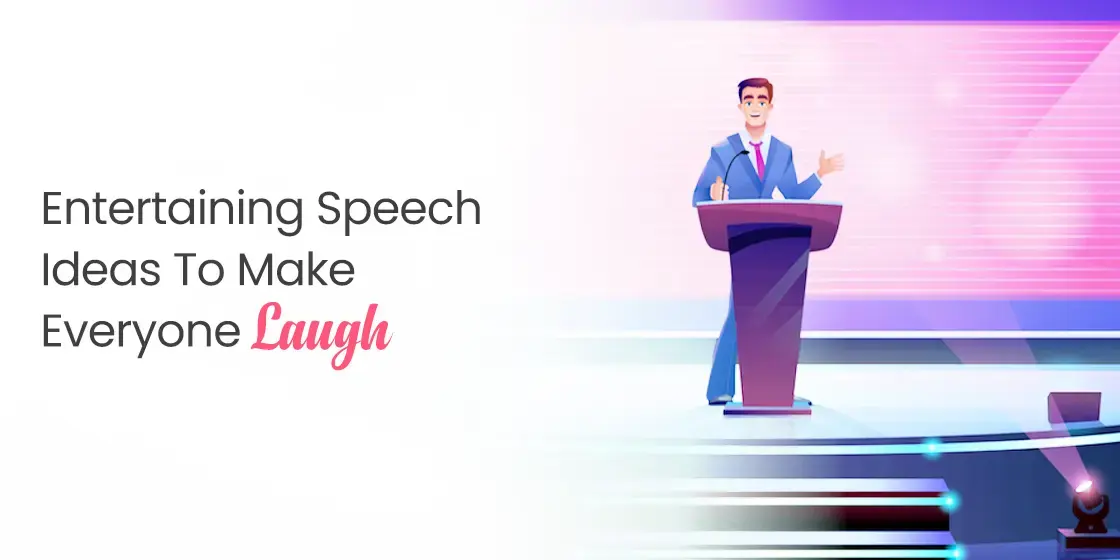Table of Content
Understanding the Ins and Outs of Demonstrative Speech for Maximum Impact
Ever watched a cooking show and found yourself completely absorbed as the chef transforms simple ingredients into something amazing? That’s the magic of a well-executed demonstrative speech – it takes your audience on a journey from confusion to clarity, from curiosity to capability.
A demonstration speech is made to teach and assist someone with step by step instructions for performing a particular task. These speeches are most often known as how-to guides over the internet. Something that sets them apart from the other informative speeches, is that they can be based on subjective preferences instead of objective facts.
Whether you’re a student preparing for class or a professional looking to share expertise, mastering the art of demonstration can transform how you communicate complex ideas. This comprehensive guide will walk you through everything you need to create speeches that don’t just inform – they inspire action. Let’s take a look at the topic from the perspective of a professional speech writing service. Let’s begin.
What is a Demonstrative Speech?

A demonstrativespeech is an informative presentation designed to teach your audience how to perform a specific task through clear, step-by-step instructions. Unlike other speech types that simply share information, demonstration speeches combine verbal explanation with visual elements to show exactly how something works or how to accomplish a goal.
Think of it as being the helpful friend who doesn’t just tell you how to change a tire – they actually show you every step while explaining why each action matters.
Key Characteristics of Effective Demonstrative Speeches
The most impactful demonstrationspeeches share several essential qualities with informative speeches:
- Process-focused structure that breaks complex tasks into manageable steps
- Visual aids and props that reinforce verbal instructions
- Interactive elements that keep audiences engaged
- Practical applications that audience members can immediately use
- Clear chronological flow that prevents confusion
Why Demonstrative Speaking Matters More Than Ever
Demonstration speeches are important because they provide a way for people to learn about new things. Sometimes, it’s important for people to see how something is done, in order to understand the process and learn the skills necessary to do it themselves. That’s why our speech writing services experts are often reached by people to craft an effective demonstration speech for them, because its success lies in effectively communicating instructions.
These types of speeches can be used to teach people about anything from cooking a meal to assembling a piece of furniture. In addition, demonstration speeches can also be used to show people how to use a new product or service.
In our digital age, the ability to explain processes clearly has become invaluable. Demonstrative speeches serve multiple crucial functions:
- Educational Impact: They transform abstract concepts into concrete, actionable knowledge that sticks with audiences long after the presentation ends.
- Professional Development: Whether you’re training colleagues, presenting to clients, or leading workshops, demonstration skills showcase expertise while building trust and credibility.
- Personal Growth: The process of breaking down complex tasks for others deepens your own understanding and reveals gaps in knowledge you might not have noticed.
- Audience Connection: Unlike purely theoretical presentations, demonstrations create shared experiences that foster genuine engagement and memorable learning moments.
Deliver a memorable speech with our
expertly crafted speeches!

What Makes a Good Demonstration Speech?
Any speech that serves its purpose is good. An informational speech that enlightens people with new knowledge is effective and successful for it has served its purpose to impart knowledge. And a good persuasive speech is one that is successful in its purpose of persuading the audience.
Similarly, a good demonstration speech is one that can make a difficult procedure simple for the audience to grasp, remember, and then perform effectively according to the instructions. Let’s take a look at the structure of an effective demonstrative speech to understand it further.
The Anatomy of Outstanding Demonstrative Speeches
All informative and demonstrative speech ideas follow a basic outline structure that comprises an introduction, body paragraph and conclusion as per the rule of three in speech writing. Demonstrative speeches as a category of informational speeches follow the same pattern. Let’s take a look at it in greater detail below.
Crafting Your Introduction: The Hook That Matters
Your opening moments determine whether audiences lean in or tune out. Start with elements that immediately grab attention:
- Relatable Problems: Begin by identifying a challenge your audience faces. “How many of you have struggled with…”
- Surprising Statistics: Share compelling data that highlights the importance of your topic. “Did you know that…”
- Personal Stories: Connect through authentic experiences that demonstrate why this skill matters to you.
- Questions That Engage: Use interactive elements to get audiences thinking immediately.
Building Your Overview: The Roadmap to Success
Before diving into step-by-step instructions, provide a clear preview that helps audiences understand what they’re about to learn:
- Number your steps so audiences know what to expect
- Highlight critical points that require special attention
- Mention required materials or preparation needed
- Set realistic expectations about difficulty level and time investment
This overview serves as a mental framework that makes complex processes easier to follow.
Developing Your Body: Step-by-Step Excellence
Each step in your demonstrative speech presentation should follow a consistent pattern:
- Announce the Step: Clearly state what you’re about to demonstrate
- Explain the Why: Help audiences understand the purpose behind each action
- Show the How: Demonstrate the actual technique or process
- Reinforce Key Points: Highlight common mistakes or essential details
- Check for Understanding: Pause to ensure everyone is following along
Crafting Your Conclusion: Beyond Simple Summary
End your demonstration speech with elements that encourage real-world application:
- Recap essential steps in condensed form
- Address variations or alternative approaches
- Provide troubleshooting tips for common challenges
- Issue a call to action that motivates audiences to try the skill themselves
- Offer additional resources for continued learning
Choosing Demonstrative Speech Topics That Resonate: How to Find the Perfect One?

Before you begin structuring your speech, it’s obviously a given that you’ll need to think of a demonstrative speech topic. When choosing one, asking yourself a few targeted questions can help you choose the best topic for your speech. Let’s explore it below in detail.
What Is Your Target Audience? Will Your Speech Benefit Them?
In choosing a topic for your demonstration speech it’s crucial to choose one according to your audience. There’s no point demonstrating something which is of no interest to your audience. Plus, it’s important to make sure that your demonstration speech provides value to the audience.
For instance, a demonstration speech on how to make an acrylic painting would be of interest to a group of painting enthusiasts, but to demonstrate that to a group of professional painters who are well-versed in different painting styles would be of no interest to them and would not provide any value.
Is The Topic Suitable For A Demonstration Speech?
Not all topics are suitable for a demonstration speech. Just because it sounds like a topic for demonstrative speech, doesn’t mean that it can be effectively delivered in a step by step sequence.
For instance, how to teach an elementary class would sound like it’s a good how-to topic for a demonstrative speech. But that’s not true, because teaching an elementary class is not something which can be divided into a step by step process.
So if a topic fails to convert into a step by step simplified sequence, think again which type of informational speech better suits its format.
Do You Have Expertise Or Adequate Knowledge To Make A Demonstration Speech On The Topic?
To make a demonstrative speech, it’s important that a speaker has adequate knowledge regarding the subject matter. The more passionate you are about a topic, the better you are able to deliver a speech.
So if it’s up to you to choose a topic, it’s best to choose it according to your own interests, otherwise, it would not work as effectively if you demonstrate something from bookish instead of practical, first-hand knowledge.
What Resources Would You Need For The Chosen Topic?
When choosing a topic one must keep in mind the resources that they’ll need to effectively demonstrate the subject matter. Suppose you have to give a demonstrative speech on swimming, however there is no swimming pool nearby to demonstrate it practically.
What resources would you then need to ensure that you properly impart the knowledge about swimming? In such a scenario, you can make use of props or visual aids such as video clips, in which the speaker themselves can demonstrate the right way of swimming with all the knitty gritty of it.
By doing so the speaker will be able to use visual aids to more effectively demonstrate things which are not accessible for demonstration in a particular setting. Just be sure whether or not you are allowed to use projectors or other visual aids for demonstration.
Ideas for Demonstration Speech Topics
Demonstration speech topics can vary in their level of difficulty and varying interest among each age group. This is something that is true for all other kinds of speeches such as in the case of motivational or persuasive speech topics.
This is why we’ve made three different categories for students seeking suggestions for best topics for a demonstration speech.
Demonstration speech topics for middle school
Demonstration speeches could be really fun for middle school students. Children and early teens are more excited to engage in activities with an unmatchable zeal.
- How to solve a Rubix cube?
- How to make a metal detector?
- How to make an antenna booster?
- How to make a sundial?
- How to make an origami?
- How to make an ice cake?
- How to plant a seed?
- How to play piano/guitar?
- How to exercise your brain?
- How to give CPR?
Demonstration speech topics for High School
- How to create viral social media content responsibly
- Essential techniques for acing job interviews
- Simple methods for managing anxiety during exams
- Steps to start a small business with minimal investment
- Basic car maintenance every teenager should know
Demonstration speech topics for College Students
- How to build a professional online presence
- Effective strategies for networking at career fairs
- Simple techniques for cooking healthy meals on a budget
- Methods for writing research papers efficiently
- Ways to develop financial literacy early
Demonstrative Speech Ideas for Professional Audiences
- How to facilitate productive virtual meetings
- Techniques for giving constructive feedback
- Steps to implement sustainable office practices
- Methods for managing remote teams effectively
- Ways to present data that drives decision-making
Creative and Engaging Topics for Arts and Crafts
- How to create stunning photography with just your smartphone
- Simple techniques for upcycling everyday objects into home decor
- Steps to start digital art without expensive software
- Methods for making natural skincare products at home
- Ways to design eye-catching social media graphics
Demonstrative Speech Topics for Technology and Digital Skills
- How to protect your personal data online
- Simple steps to automate repetitive tasks
- Techniques for creating professional presentations
- Methods for building a basic website
- Ways to use AI tools ethically and effectively
Demonstration Speech Ideas for Health and Wellness
- How to create a morning routine that actually sticks
- Simple techniques for improving posture while working
- Steps to practice mindfulness during busy days
- Methods for preparing healthy meals in under 30 minutes
- Ways to set up an ergonomic workspace at home
Demonstrative Speech Tips
There are some additional things that can be done to make your demonstrative speech more effective, engaging and memorable. Let us share with you some ideas on how to write a speech that will definitely improve your speech.
Encourage Audience Participation
Choose a suitable demonstration speech topic wherein the audience can join you in during the demonstration process. You can ask them to repeat a fun slogan or a catchy tagline with you while you demonstrate something.
Also, you can call someone from the crowd to assist you with something. Such as, to hold equipment or to help you demonstrate something. For example, if your demonstration speech is about how to counter bullying, you can ask someone from the audience to help you demonstrate it.
Once you have someone on stage, ask them to be mean with you. Then, you can demonstrate how such an encounter can be prevented from further escalation by being very sweet to them. This ought to make them feel embarrassed or hesitant to continue.
By demonstrating something in a practical manner, you can actually substantiate your authority to make that speech. Similarly, there are several other ways to make a boring demonstration fun by being creative.
Provide Resource Material
Another method for ensuring that your demonstration speech becomes memorable is to create resource material for the audience, for instance, in the form of an infographic.
This way, the audience will have something concrete to take away with themselves as a souvenir or reminder of learning something they too were passionate about.
End with a Call-to-Action
A great way to end your demonstrative speech is by inspiring your audience to take action. This could be done with a simple call to action, or you can challenge them to do something related to what they just learned.
For example, you could ask them to try out the new recipe that you just demonstrated or challenge them to use the new painting technique in their next art project.
Doing so will make your demonstration speech more impactful, as the very purpose of it is to help the audience learn to practically implement the given instructions in a particular task or activity.
Mastering Visual Aids for Maximum Impact – A Demonstrative Speech Criticality

The trick to mastering the demonstrative speech niche is knowing and finding the right visual aids to drive home your point. Let’s take a look at how you can make your speech more impactful with the help of visuals.
Types of Visual Aids That Work
- Physical Props: Real objects that audiences can see and sometimes touch create the strongest connection to your content. When demonstrating cooking techniques, actual ingredients and tools are far more effective than photographs.
- Digital Presentations: Well-designed slides support your verbal explanation without overwhelming audiences. Keep text minimal and images large and clear.
- Live Demonstrations: Nothing beats showing the actual process in real time. Practice extensively to ensure smooth execution, and always have backup plans for technical difficulties.
- Interactive Displays: For smaller groups, tabletop setups where audiences can examine materials up close create more engaging experiences.
- Video Components: Short clips can effectively demonstrate processes that are difficult to perform live, especially when safety concerns or space limitations exist.
Best Practices for Visual Aid Integration
- Keep It Simple: Each visual should serve a clear purpose. Avoid cluttered slides or too many props that divide attention.
- Ensure Visibility: Test your setup from the back of the room. If someone in the last row can’t see clearly, your visual aid won’t be effective.
- Practice Smooth Transitions: Fumbling with equipment or struggling to advance slides disrupts your flow and loses audience engagement.
- Have Backup Plans: Technology fails at the worst possible moments. Always prepare alternatives for essential visual elements.
Audience Engagement: How to Get Your Speech Audience Hooked
The mark of a good orator is that their audience is glued to them to hear what they have to say next. Here is how you can improve your audience engagement today for better demonstrative speeches.
Interactive Elements That Work
- Audience Participation: Invite volunteers to assist with demonstrations. This creates investment and helps break down complex processes through guided practice.
- Question Integration: Rather than saving questions for the end, pause periodically to address concerns and ensure comprehension.
- Prediction Activities: Before revealing the next step, ask audiences to guess what comes next. This keeps minds active and engaged.
- Skill Practice: When possible, provide materials for audiences to try techniques themselves during your presentation.
Handling Challenges Gracefully: When Your Speech Doesn’t Go As Planned
- When Things Go Wrong: Mistakes happen, especially in live demonstrations. Use these moments as teaching opportunities rather than sources of embarrassment.
- Managing Different Learning Speeds: Some audience members will grasp concepts quickly while others need more time. Build in flexibility to accommodate various learning styles.
- Addressing Unexpected Questions: Prepare for questions that go beyond your planned content. It’s perfectly acceptable to say “I don’t know, but I’ll find out” when faced with unfamiliar territory.
Common Mistakes to Avoid in Demonstrative Speeches
- Choosing Overly Complex Topics: Select processes that can be meaningfully demonstrated within your time constraints. It’s better to cover fewer steps thoroughly than rush through too many.
- Ignoring Audience Knowledge Levels: Tailor your language and examples to match your audience’s familiarity with the subject. Don’t assume prior knowledge, but also avoid being condescending.
- Insufficient Practice: Demonstrative speeches require more rehearsal than other presentation types because you’re coordinating verbal, visual, and physical elements simultaneously.
- Speaking Too Fast: The excitement of demonstration often leads to rushed delivery. Maintain steady pacing that allows audiences to process each step fully.
- Blocking the View: Pay attention to your positioning relative to visual aids. Make sure everyone can see your demonstrations clearly.
- Forgetting Interaction: Don’t become so focused on your process that you forget to engage with your audience. Maintain eye contact and check for understanding throughout.
Practice Exercises to Build Your Demonstrative Speech Skills: From Starter to Advanced

Exercise 1: Choose a simple daily task you perform automatically, like making coffee or tying shoes. Practice explaining each step out loud as if teaching someone who’s never done it before. This builds awareness of assumptions and gaps in instructions.
Exercise 2: Record yourself demonstrating a 3-minute process. Watch the recording and identify moments where your explanation was unclear, your positioning blocked the view, or your pacing felt rushed.
Exercise 3: Practice with different audience types. Demonstrate the same process to friends, family members, and colleagues. Notice how you naturally adjust your language and examples for different groups.
Building Advanced Techniques
Exercise 4: Develop contingency plans for your demonstrations. What happens if your technology fails? If you forget a crucial material? If someone asks a question you can’t answer? Preparing for challenges builds confidence.
Exercise 5: Experiment with different engagement techniques. Try the same demonstration with various interaction styles – questions, volunteers, predictions – and notice which approaches feel most natural and effective.
Resources for Continued Growth: Essential Tools, Materials, and Learning Resources
- Recording Equipment: Use your smartphone to practice and review your demonstrations. Video reveals positioning and pacing issues that you might miss in the moment.
- Presentation Software: Beyond basic PowerPoint, explore tools like Canva for graphics, Loom for screen recordings, or Prezi for interactive presentations.
- Props and Materials: Invest in quality visual aids that will last through multiple presentations. Clear, professional-looking materials enhance your credibility.
Speech Giving Learning Opportunities
- Toastmasters International: Provides structured opportunities to practice demonstrative speeches with supportive feedback.
- Online Courses: Platforms like Coursera, Udemy, and LinkedIn Learning offer specific training in presentation skills and visual design.
- Professional Workshops: Industry conferences often include sessions on effective communication and demonstration techniques.
FAQs
| What is a good example of a demonstration speech? A good example of demonstration speech is to speak on topics that provide a unique proposition to the audience. It’s best to speak on “My recipe for baking chocolate chip cookies”, rather than “How you should bake a cookie”. That’s because there is no definitive way of baking a good chocolate chip cookie. |
| What is demonstration in business communication? In business communication a demonstration is usually based on the promotion of a product or service. Marketers can demonstrate to the potential customers about why and how to use a product or service. |
| What is demonstration learning? It is believed that when students are able to effectively demonstrate something that they have learnt, it suggests that they have successfully understood the subject matter. This is why schools and colleges hold class presentations, debates, and speeches to gauge whether or not they have achieved the expected level of proficiency. |
| How long should a demonstrative speech be? Most effective demonstrative speeches run 5-15 minutes, depending on topic complexity and audience needs. The key is matching your content to available time rather than rushing through too much material. |
| What if I make a mistake during my demonstration? Embrace mistakes as learning opportunities! Acknowledge what happened, explain the correct approach, and show how to recover. Audiences often remember and appreciate authentic moments more than perfect performances. |
| How do I choose between different demonstration methods? Consider your audience’s learning preferences, available resources, and safety requirements. Live demonstrations create the strongest impact when feasible, but video or step-by-step slides work better for complex or potentially dangerous processes. |
| Should I provide written materials for my audience? Yes, handouts with key steps, resource lists, or troubleshooting tips help audiences apply what they’ve learned later. Design materials that complement rather than duplicate your verbal presentation. |
Conclusion
Mastering demonstrative speech requires practice, patience, and willingness to learn from both successes and failures. Remember that every expert was once a beginner who kept practicing despite imperfect early attempts.
Start with topics you know well and audiences who are supportive. As your confidence grows, tackle more complex subjects and diverse groups. Pay attention to audience feedback – both verbal and non-verbal – and use it to refine your approach.
The skills you develop through demonstrative speaking will serve you throughout your personal and professional life. Whether you’re training new employees, teaching your children life skills, or sharing expertise with colleagues, the ability to break down complex processes into clear, actionable steps makes you a more effective communicator and leader.

Unleash your brand story`s potential with eContentSol – your creative writing companion. We craft narratives that captivate. Ready to elevate your content game? Dive into creativity with us and let`s bring your ideas to life.


